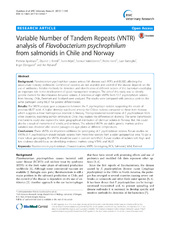| dc.contributor.author | Apablaza, Patricia | |
| dc.contributor.author | Brevik, Øyvind Jakobsen | |
| dc.contributor.author | Mjøs, Svein Are | |
| dc.contributor.author | Valdebenito, Samuel | |
| dc.contributor.author | Ilardi, Pedro | |
| dc.contributor.author | Battaglia, Juan | |
| dc.contributor.author | Dalsgaard, Inger | |
| dc.contributor.author | Nylund, Are | |
| dc.date.accessioned | 2016-03-10T14:25:21Z | |
| dc.date.available | 2016-03-10T14:25:21Z | |
| dc.date.issued | 2015-07-14 | |
| dc.Published | BMC Veterinary Research 2015, 11:150 | eng |
| dc.identifier.issn | 1746-6148 | en_US |
| dc.identifier.uri | http://hdl.handle.net/1956/11608 | |
| dc.description.abstract | Background Flavobacterium psychrophilum causes serious fish diseases such RTFS and BCWD, affecting the aquaculture industry worldwide. Commercial vaccines are not available and control of the disease depends on the use of antibiotics. Reliable methods for detection and identification of different isolates of this bacterium could play an important role in the development of good management strategies. The aim of this study was to identify genetic markers for discrimination between isolates. A selection of eight VNTRs from 53 F. psychrophilum isolates from Norway, Chile, Denmark and Scotland were analyzed. The results were compared with previous work on the same pathogen using MLST for genetic differentiation. Results The VNTR analysis gave a separation between the F. psychrophilum isolates supporting the results of previous MLST work. A higher diversity was found among the Chilean isolates compared to those from Norway, which suggests a more homogenous reservoir in Norway. Transgenerational transmission of F. psychrophilum from other countries, exporting salmon embryos to Chile, may explain the differences in diversity. The same transmission mechanisms could also explain the wide geographical distribution of identical isolates in Norway. But, this could also be a result of movement of smolts and embryos. The selected VNTRs are stable genetic markers and no variation was observed after several passages on agar plates at different temperatures. Conclusions These VNTRs are important additions for genotyping of F. psychrophilum isolates. Future studies on VNTRs of F. psychrophilum should include isolates from more host species from a wider geographical area. To get a more robust genotyping the VNTRs should be used in concert with MLST. Future studies of isolates with high and low virulence should focus on identifying virulence markers using VTNRs and MLST. | en_US |
| dc.language.iso | eng | eng |
| dc.publisher | BioMed Central | en_US |
| dc.rights | Attribution CC BY | eng |
| dc.rights.uri | http://creativecommons.org/licenses/by/4.0/ | eng |
| dc.subject | Flavobacterium psychrophilum | eng |
| dc.subject | Characterization | eng |
| dc.subject | VNTR | eng |
| dc.subject | Genotyping | eng |
| dc.subject | PCA | eng |
| dc.subject | Salmonid | eng |
| dc.subject | Wild | eng |
| dc.subject | Farmed | eng |
| dc.title | Variable Number of Tandem Repeats (VNTR) analysis of Flavobacterium psychrophilum from salmonids in Chile and Norway | en_US |
| dc.type | Peer reviewed | |
| dc.type | Journal article | |
| dc.date.updated | 2015-11-09T14:01:43Z | |
| dc.description.version | publishedVersion | en_US |
| dc.rights.holder | Copyright 2015 the authors | en_US |
| dc.identifier.doi | https://doi.org/10.1186/s12917-015-0469-7 | |
| dc.identifier.cristin | 1263386 | |
| dc.subject.nsi | VDP::Landbruks- og fiskerifag: 900::Fiskerifag: 920::Akvakultur: 922 | |
| dc.subject.nsi | VDP::Agriculture and fisheries science: 900::Fisheries science: 920::Aquaculture: 922 | |
| dc.subject.nsi | VDP::Landbruks- og fiskerifag: 900::Fiskerifag: 920::Fiskehelse : 923 | |
| dc.subject.nsi | VDP::Agriculture and fisheries science: 900::Fisheries science: 920::Fish health: 923 | |

